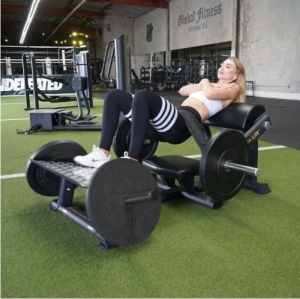
How to Train Legs in the Gym: The Ultimate Guide to Reps, Exercises, and Machines

12/12/24
I’ll never forget my first serious leg day at the gym. A friend, who I now suspect was secretly trying to break me, introduced me to squats, lunges, and Romanian deadlifts all in one session. The next day, I could barely get out of bed, let alone get down a flight of stairs without clinging to the rail. But that soreness? It was a badge of honour and a sign that I’d started building a strong foundation for my fitness.
If you’ve ever had a similar experience or are gearing up for your first proper leg day, this guide is for you. Training your legs is challenging, but the payoff is immense: stronger performance, better stability, and a more balanced physique. Here’s how to do it, with the best exercises, machines, and rep ranges to make the most of every session.
Key Leg Muscles to Train
Understanding the major muscles in your legs helps you tailor your workouts for balanced development:
- Quadriceps (Quads) - Front of the thigh; responsible for knee extension.
- Hamstrings - Back of the thigh; responsible for knee flexion and hip extension.
- Gluteus Maximus (Glutes) - Your buttocks; critical for hip extension and stability.
- Calves - Lower leg muscles (gastrocnemius and soleus); involved in ankle flexion.
- Adductors and Abductors - Inner and outer thighs; essential for leg movement and stability.
The Best Leg Exercises and Machines
Here’s a breakdown of top leg exercises, the machines used, and the muscles they work:
Squats (Barbell or Machine-Assisted)
- Muscles Worked: Quads, glutes, hamstrings, calves, and core.
- Why It’s Great: The king of leg exercises, squats build overall strength and power.
- Reps: 8-12 reps for hypertrophy; 4-6 for strength.
Leg Press Machine
- Muscles Worked: Quads, glutes, hamstrings.
- Why It’s Great: A controlled alternative to squats, ideal for isolating the quads and glutes.
- Reps: 10-15 for muscle endurance or 8-10 for strength.
Lunges (Dumbbell or Machine-Assisted)
- Muscles Worked: Quads, glutes, hamstrings, and stabilizers.
- Why It’s Great: Targets one leg at a time for balanced strength and stability.
- Reps: 10-12 per leg.
Romanian Deadlifts (RDLs)
- Muscles Worked: Hamstrings, glutes, lower back.
- Why It’s Great: A powerful posterior chain exercise that improves hamstring flexibility and strength.
- Reps: 8-10 with heavier weights.
Leg Curl Machine
- Muscles Worked: Hamstrings.
- Why It’s Great: Isolates the hamstrings for balanced leg strength.
- Reps: 10-15 for endurance, 8-12 for hypertrophy.
Leg Extension Machine
- Muscles Worked: Quads.
- Why It’s Great: Perfect for isolating and defining the quads.
- Reps: 12-15 for muscle endurance, 10-12 for strength.
Calf Raises (Standing or Seated Machine)
- Muscles Worked: Gastrocnemius (standing) and soleus (seated).
- Why It’s Great: Focused on developing strong, defined calves.
- Reps: 15-20 for endurance, 10-15 for strength.
Hip Thrusts (Barbell or Machine)
- Muscles Worked: Glutes, hamstrings, lower back.
- Why It’s Great: Activates the glutes like no other exercise, improving overall lower-body power.
- Reps: 10-12 with moderate to heavy weight.
How Many Sets and Reps?
The rep range and sets you choose depend on your goals:
- Strength: 3-5 sets of 4-6 reps with heavier weights.
- Hypertrophy (Muscle Growth): 3-4 sets of 8-12 reps with moderate weights.
- Endurance: 3-4 sets of 12-20 reps with lighter weights.
Sample Leg Day Routine
Warm-Up:
- 5-10 minutes of dynamic stretching and light cardio.
Workout:
- Barbell Squats: 4 sets x 6-8 reps.
- Leg Press: 4 sets x 10-12 reps.
- Romanian Deadlifts: 3 sets x 8-10 reps.
- Leg Curls: 3 sets x 10-12 reps.
- Walking Lunges: 3 sets x 10-12 reps per leg.
- Standing Calf Raises: 4 sets x 15-20 reps.
Cool Down:
- Static stretching focusing on quads, hamstrings, glutes, and calves.
Tips for a Successful Leg Day
- Progressive Overload: Gradually increase the weight or reps to keep challenging your muscles.
- Form First: Always prioritise proper form to prevent injuries and increase effectiveness.
- Rest and Recovery: Allow 48-72 hours of recovery before training legs again.
- Nutrition: Fuel your muscles with protein and carbs post-workout to support recovery and growth.
Leg training is demanding but immensely rewarding. By incorporating these exercises, machines, and rep ranges into your routine, you’ll build a powerful, balanced lower body ready to support all your fitness goals.
Browse by category
Recent posts
Talk to our team
Don't wait - elevateyour fitness space today!





